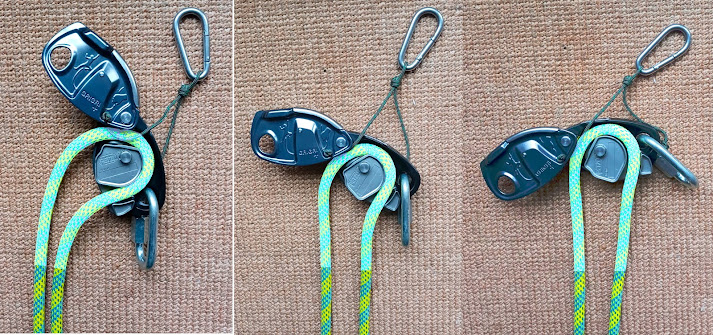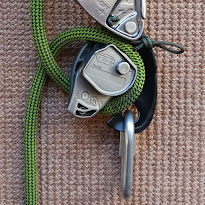The Revo is a relatively well known self-belay device in rope solo circles that is used as a poor man’s Silent Partner - that is, a bi-directional feed device that operates on the basis of centrifugal force/speed lock to stop rope feed. The main advantages are the ease of feed and the ability to catch head first falls. However, it is seldom used/mentioned as a TR solo device. It’s possible to use if for both LRS and TRS if you’re aware of its limitations and are willing to use it within those constraints. I will not detail the use of it as a LRS device as there is plenty info/resources on that if one searches. This will detail my experiments and limited use of it for TRSing.
First, a bit of background info on the Revo. Functionally it is two separate devices in one. For normal belaying, it is similar to an ATC, where one hand always stays on the brake strand holding it in the event of a fall. The climber’s fall is stopped by the friction of the rope being forced down into both the “V” slots ears. Functionally this is no different than an ATC.
Secondly, the Revo also has a backup system in case the primary system fails. I.e. if the belayer were to lose their grip on the rope and it started zipping through the device. In this scenario, the internal wheel starts spinning and at a certain speed (~4 m/sec), the centrifugal force cause cogs to pivot outward that catch in notches in the body and stop the rotation of the wheel. The wheel is like a narrow “V” groove pulley with internal ridges which provide friction on the rope, stopping it from sliding through the device. This operates independently of the external ears/jaws.
It is this second function that is of interest for LRS/TRS. The first ATC-like function of the external ears/jaws actually can cause additional friction that impedes the rotational speed of the wheel and thus slightly delays the lock-up. When the Revo is used for TRS these ears/jaws also cause extra friction on the rope which makes the feed less than desirable. (There are other undesirable features but they’ll be covered below at the end of the post).
This friction of the jaws on the rope can be mitigated to a degree by having the rope pass through a fat aluminum belay ring as it exits the Revo (see lead photo). This acts as a smooth bearing surface that protects the rope from getting sucked into the jaws and causing friction of the TRS rope feed. This can be easily tested by getting a rappel ring (the fat, totally round cross-section ones work best: https://hownot2.com/products/aluminum-rappel-ring) and stuffing a bight of the rope through it before inserting it into the Revo.
Drawbacks
There are several drawbacks to using the Revo as a TRS device. Ultimately this is why I moved on to other devices (see my other blog posts other devices I've used). If interested, you should assess its strengths and weaknesses in relation to your routes, goals, style, and risk assessment.
- Rappelling: Because the rap ring functions to decrease the friction of the ears/jaws on the rope, this means that it takes an inordinate amount of pressure holding the free strand of rope to keep a controlled decent. There are many ways this can be mitigated such as using a Freino ‘biner; putting a bight of rope around the load strand; putting on an ATC below the Revo; or using a ‘biner and quick link in line to create a makeshift 'biner brake to create additional friction; etc. I'm sure there are other ways also.
- There is no immediate lock-up like many TRS devices when weighting or falling on the device because the of the speed actuated lock-up. It takes 3’-4’ to lock up (unless you have modded the internal spring inside the Revo.) This can be disconcerting if that’s what you are used to, if you’re climbing pushing or limits, or if you are climbing on terrain with objective hazards where you want an immediate lock-up. If you’re on overhung terrain and or mainly climbing below your red-point limit, it is less disconcerting once you practice and get use to the delayed lock-up.
- Finally, once locked up and hanging on the Revo, there is the possibility of it unlocking due to the weight of the free rope. This could result in a repetitive lock/unlock situation that while disconcerting, is probably not dangerous in most situations. Only experimentation with it will tell if this will be an issue for you. It depends upon the weight of the free rope which is an interplay of the the height of the climb, size/weight of the rope, and the friction on the rope caused by the terrain (i.e. if less than vertical).
TRS Conclusion:
If you’re interested in just using the Revo for TRS and have tested the rap ring and considered all the factors above, you can stop reading here. If you’re interested in using it for BOTH, TRS and LRS, read on, as there is a modification to the ring that will make it easier to use for both. The modified ring is NOT necessary if you are only going to use it for TRS.
Modifying the rappel ring for LRS
If you also use the Revo for LRS and would like to use the rap ring for TRS, there is a mod that can be performed that will turn the Revo into an “all-in-one-device” by leaving the rappel ring permanently attached to the Revo. Leaving it permanently attached does not interfere with LRS (or TRS).
Steps for modifying the rap ring
- Drill a series of holes to make a groove in a 2x4 to hold the ring securely vertically while drilling it.
- Clamp block to drill press to hold it steady.
- Drill hole, slightly larger diameter than the cord, that goes through the side of the rappel ring. Getting the hole started is the biggest challenge and might require you to start the hole perpendicular to the ring then turn it 90 deg..
- Use a larger drill bit or a conical grinding burr on a Dremel tool to slightly chamfer the edge of the cord hole.
- Feed a 6”-8” piece of 2mm accessory cord through the drilled hole in the rappel ring
- Tie each end of the cord to each side of the jaw using an overhand knot.
- Cut ends close and burn/melt the ends.
Addendum
If you don’t like the idea of attaching the rappel ring “permanently” to the Revo, you can also put a larger loop of cord through it and tie it off in a loop that hangs the ring from the ‘biner. You’ll need to play with the length of the cord to get it just right. I personally did not care for this method as well as the method detailed above.


What I would do differently:
Instead of the Revo hanging down from the belay loop, I would attach a chest harness/lanyard to the Revo ‘biner and hold it up. This will keep it from sliding up and down the belay loop and slightly shorten the distance of a fall. It will also hold the Revo higher up so that it will be easier to grab the rope for clipping. In some of the photos you can see some of my experiments for attaching the Revo with a cord directly to the harness and in others the holding the 'biner up on the belay loop with accessory cord.


































.jpg)
.jpg)



















